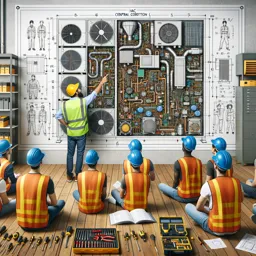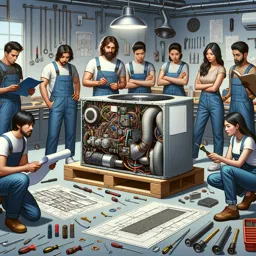Starting a career as an air conditioning technician requires not only a solid foundation of knowledge and skills but also the right tools and equipment. Proper training courses will cover the use of these essential items, ensuring that technicians are well-prepared for any job. Here is a detailed look at the essential tools and equipment every air conditioning technician should have.
1. Multimeter
A multimeter is an indispensable tool for any air conditioning technician. It is used to measure voltage, current, and resistance in electrical components. This tool helps in diagnosing electrical issues and ensuring that systems are operating safely and efficiently.
2. Thermometer
Accurate temperature measurement is crucial in the HVAC industry. Digital thermometers allow technicians to measure air and surface temperatures quickly and precisely, helping to diagnose and troubleshoot system issues.
3. Manifold Gauge Set
A manifold gauge set is used to measure the pressure of refrigerants in an air conditioning system. This tool is essential for diagnosing and servicing HVAC systems, ensuring they are charged correctly and operating efficiently.
4. Refrigerant Scale
A refrigerant scale is used to measure the exact amount of refrigerant added to or removed from an HVAC system. This ensures the system operates at peak efficiency and complies with environmental regulations.
5. Vacuum Pump
A vacuum pump is used to remove air and moisture from HVAC systems before charging them with refrigerant. This process is crucial for the efficient operation of the system and prevents contamination.
6. Leak Detector
Detecting refrigerant leaks is a critical part of maintaining and repairing HVAC systems. Electronic leak detectors help technicians find even the smallest leaks, ensuring the system operates efficiently and safely.
7. Cordless Drill
A cordless drill is an essential tool for installing and servicing air conditioning units. It is used for drilling holes, driving screws, and other tasks that require power and precision.
8. Pipe Wrench
Pipe wrenches are used to grip and turn pipes and fittings. They come in various sizes and are essential for installing and servicing HVAC systems, particularly when dealing with plumbing connections.
9. Service Wrench
Service wrenches are specifically designed for working on HVAC systems. They are used to open and close service valves, making them an essential tool for refrigerant management and system servicing.
10. Safety Gear
Safety gear, including gloves, goggles, and ear protection, is crucial for protecting technicians from potential hazards. Proper training emphasizes the importance of safety and the use of personal protective equipment (PPE) on the job.
11. Fin Comb
Fin combs are used to straighten and clean the fins on air conditioning units. Damaged or dirty fins can reduce the efficiency of the unit, so maintaining them is an important part of regular service.
12. Tubing Cutter
A tubing cutter is used to cut copper and other types of tubing used in HVAC systems. This tool provides a clean, precise cut, which is essential for ensuring proper connections and system integrity.
13. Caulking Gun
A caulking gun is used to apply sealants and adhesives. Proper sealing prevents air leaks and ensures the efficiency and longevity of the HVAC system.
14. Extension Ladder
An extension ladder is often necessary for reaching outdoor units or systems installed at height. Safety training includes the proper use of ladders to prevent accidents.
15. Tool Bag or Box
A sturdy tool bag or box is essential for keeping all tools organized and easily accessible. It ensures that technicians can quickly find the tools they need for any job.
Conclusion
Equipping yourself with the right tools and equipment is essential for success as an air conditioning technician. Quality training courses will cover the use of these tools, ensuring that you are well-prepared to handle any task with confidence and professionalism. By mastering these tools and continually updating your knowledge, you’ll be well on your way to a successful career in the HVAC industry.






















